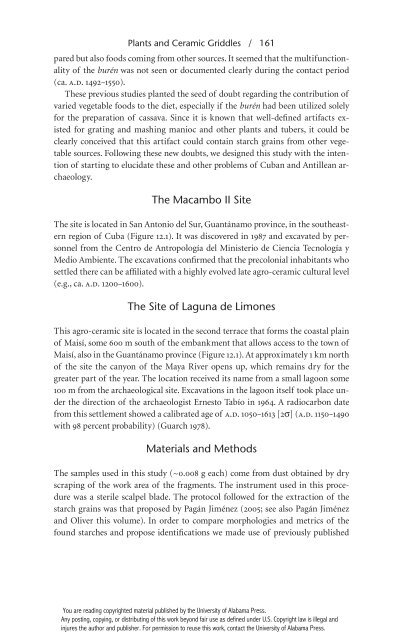Crossing the Borders: New Methods and Techniques in the Study of Archaeological Materials from the Caribbean
by Corrine L. Hoffman, et. al.
by Corrine L. Hoffman, et. al.
You also want an ePaper? Increase the reach of your titles
YUMPU automatically turns print PDFs into web optimized ePapers that Google loves.
Plants <strong>and</strong> Ceramic Griddles / 161<br />
pared but also foods com<strong>in</strong>g <strong>from</strong> o<strong>the</strong>r sources. It seemed that <strong>the</strong> multifunctionality<br />
<strong>of</strong> <strong>the</strong> burén was not seen or documented clearly dur<strong>in</strong>g <strong>the</strong> contact period<br />
(ca. a.d. 1492–1550).<br />
These previous studies planted <strong>the</strong> seed <strong>of</strong> doubt regard<strong>in</strong>g <strong>the</strong> contribution <strong>of</strong><br />
varied vegetable foods to <strong>the</strong> diet, especially if <strong>the</strong> burén had been utilized solely<br />
for <strong>the</strong> preparation <strong>of</strong> cassava. S<strong>in</strong>ce it is known that well- def<strong>in</strong>ed artifacts existed<br />
for grat<strong>in</strong>g <strong>and</strong> mash<strong>in</strong>g manioc <strong>and</strong> o<strong>the</strong>r plants <strong>and</strong> tubers, it could be<br />
clearly conceived that this artifact could conta<strong>in</strong> starch gra<strong>in</strong>s <strong>from</strong> o<strong>the</strong>r vegetable<br />
sources. Follow<strong>in</strong>g <strong>the</strong>se new doubts, we designed this study with <strong>the</strong> <strong>in</strong>tention<br />
<strong>of</strong> start<strong>in</strong>g to elucidate <strong>the</strong>se <strong>and</strong> o<strong>the</strong>r problems <strong>of</strong> Cuban <strong>and</strong> Antillean archaeology.<br />
The Macambo II Site<br />
The site is located <strong>in</strong> San Antonio del Sur, Guantánamo prov<strong>in</strong>ce, <strong>in</strong> <strong>the</strong> sou<strong>the</strong>astern<br />
region <strong>of</strong> Cuba (Figure 12.1). It was discovered <strong>in</strong> 1987 <strong>and</strong> excavated by personnel<br />
<strong>from</strong> <strong>the</strong> Centro de Antropología del M<strong>in</strong>isterio de Ciencia Tecnología y<br />
Medio Ambiente. The excavations confirmed that <strong>the</strong> precolonial <strong>in</strong>habitants who<br />
settled <strong>the</strong>re can be affiliated with a highly evolved late agro- ceramic cultural level<br />
(e.g., ca. a.d. 1200–1600).<br />
The Site <strong>of</strong> Laguna de Limones<br />
This agro- ceramic site is located <strong>in</strong> <strong>the</strong> second terrace that forms <strong>the</strong> coastal pla<strong>in</strong><br />
<strong>of</strong> Maisí, some 600 m south <strong>of</strong> <strong>the</strong> embankment that allows access to <strong>the</strong> town <strong>of</strong><br />
Maisí, also <strong>in</strong> <strong>the</strong> Guantánamo prov<strong>in</strong>ce (Figure 12.1). At approximately 1 km north<br />
<strong>of</strong> <strong>the</strong> site <strong>the</strong> canyon <strong>of</strong> <strong>the</strong> Maya River opens up, which rema<strong>in</strong>s dry for <strong>the</strong><br />
greater part <strong>of</strong> <strong>the</strong> year. The location received its name <strong>from</strong> a small lagoon some<br />
100 m <strong>from</strong> <strong>the</strong> archaeological site. Excavations <strong>in</strong> <strong>the</strong> lagoon itself took place under<br />
<strong>the</strong> direction <strong>of</strong> <strong>the</strong> archaeologist Ernesto Tabío <strong>in</strong> 1964. A radiocarbon date<br />
<strong>from</strong> this settlement showed a calibrated age <strong>of</strong> a.d. 1050–1613 [2σ] (a.d. 1150–1490<br />
with 98 percent probability) (Guarch 1978).<br />
<strong>Materials</strong> <strong>and</strong> <strong>Methods</strong><br />
The samples used <strong>in</strong> this study (~0.008 g each) come <strong>from</strong> dust obta<strong>in</strong>ed by dry<br />
scrap<strong>in</strong>g <strong>of</strong> <strong>the</strong> work area <strong>of</strong> <strong>the</strong> fragments. The <strong>in</strong>strument used <strong>in</strong> this procedure<br />
was a sterile scalpel blade. The protocol followed for <strong>the</strong> extraction <strong>of</strong> <strong>the</strong><br />
starch gra<strong>in</strong>s was that proposed by Pagán Jiménez (2005; see also Pagán Jiménez<br />
<strong>and</strong> Oliver this volume). In order to compare morphologies <strong>and</strong> metrics <strong>of</strong> <strong>the</strong><br />
found starches <strong>and</strong> propose identifications we made use <strong>of</strong> previously published<br />
You are read<strong>in</strong>g copyrighted material published by <strong>the</strong> University <strong>of</strong> Alabama Press.<br />
Any post<strong>in</strong>g, copy<strong>in</strong>g, or distribut<strong>in</strong>g <strong>of</strong> this work beyond fair use as def<strong>in</strong>ed under U.S. Copyright law is illegal <strong>and</strong><br />
<strong>in</strong>jures <strong>the</strong> author <strong>and</strong> publisher. For permission to reuse this work, contact <strong>the</strong> University <strong>of</strong> Alabama Press.


















